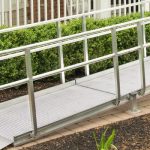
When you’d like to make the entrance to your home or business accessible, you might not be sure of your best option. Wheelchair ramps have long been a popular accessibility solution, but these days, vertical wheelchairs lifts are catching up fast.
Which one will make the most sense for you? Look at the details and the benefits of installing vertical wheelchair lifts vs ramps to make an informed decision.
What Is A Vertical Wheelchair Lift?
A vertical platform lift (also known as a VPL or a “porch lift”) is a simple elevator-style device. Its sturdy platform may be raised or lowered straight up or down by means of a motor. VPLs can take several forms — an enclosed space complete with walls and ceiling or partly or totally open. They are suitable for residential use or for small commercial buildings.
What Is A Wheelchair Ramp?
A wheelchair ramp is an inclined pathway to a building entrance. Its mild slope allows wheelchair users and other people with mobility challenges to ascend gradually. Wheelchair ramps are usually built of aluminum and steel.
Things To Consider:
1. Height & Space
A vertical platform lift (porch lift) can ascend up to 4.27 metres yet requires only a small amount of space. Its platform measures a maximum of 1.5 x 1.5 metres and doesn’t increase with height. As a result, a VPL will leave you more room for lawn or flower beds, parking, commercial displays, and so on. It’s ideal for urban areas where space is at a premium.
A ramp can ascend only up to 1.82 metres. You must allow sufficient space for its length, which is based on how high the ramp needs to rise. To avoid an overly steep slope, the recommended rise-to-length ratio is 1:12. TO ILLUSTRATE: If your steps total 50 centimetres in height, you’ll need a ramp at least 6 metres long (50 cm times 12) to accommodate a person in a wheelchair comfortably and safely.
2. Cost
The cost to install a platform lift varies according to the following factors:
- Lifting height
- Make & model
- Optional features
Any preparation necessary prior to porch lift installation, such as levelling the ground or pouring a concrete pad of 1.5 x 2.5 metres minimum. You’ll also need extra time and money to obtain any required building permits. However, if you already have a concrete pad next to your entrance stairs (perhaps as part of a sidewalk or parking area), the cost will be reduced.
The cost to install a wheelchair ramp is also quite variable, depending on:
- Amount of rise required. Remember: the shallower the rise, the shorter the ramp will need to be. For a rise of just a couple of steps, a ramp could turn out to be the more cost-effective solution.
- Type of material aluminum or steel are the best materials to use.
- Complexity of the ramp design
- Ongoing Maintenance Costs: Vertical platform lifts will need regular inspection and occasionally mechanical repair. On the other hand, aluminium and steel ramps can be customized with the paint colour of your choice to match the style of your home or business.
3. Installation Time
Speedy installation is often an urgent priority when a household member is about to come home from the hospital or rehabilitation centre.
Porch lifts take less than a day to install if the concrete pad is already in place.
Ramps take as long as several weeks — except modular aluminum ramps, which — similar to lifts — may be installed in a few hours.
Consider ease of de-installation, as well. For example, lifts and modular ramps are not difficult to remove if they are no longer needed or if you sell your house. However, a custom-built ramp can be complicated to remove.
4. User Safety & Convenience
Most important of all is the safety and convenience of the individual(s) using the ramp or lift.
Using a porch lift requires only minimal effort to operate the simple, accessible controls. In addition, VPLs comfortably accommodate all mobility devices, including power or manual wheelchairs, motorized scooters, walkers, and rollators. (They are also suitable for people with disabilities such as heart disease or arthritis, who don’t use mobility devices but find climbing stairs taxing.) A vertical platform lift may be fully enclosed or installed inside a garage for shelter from the elements.
A ramp tends to be less convenient. Ascending and descending even a slight slope can be challenging, even risky, especially if the ramp is slippery due to snowy or icy conditions. Exposure to severe weather — like cold, rain, or strong sun — may be unpleasant.
However, one limitation of a VPL is that the maximum allowable weight is commonly 340 kilograms. That has to include the user, their wheelchair and any medical accessories such as oxygen tanks, plus shopping packages and personal items (purse, briefcase, water bottles, and so on).
Specialist Guidance For Your Accessibility Solutions
The choice between a wheelchair ramp or a vertical platform lift is not a simple one. Fortunately, we have trained consultants on staff to help you explore your options and arrive at the best choice for your needs and budget. Contact us for your specialist consultation today.

